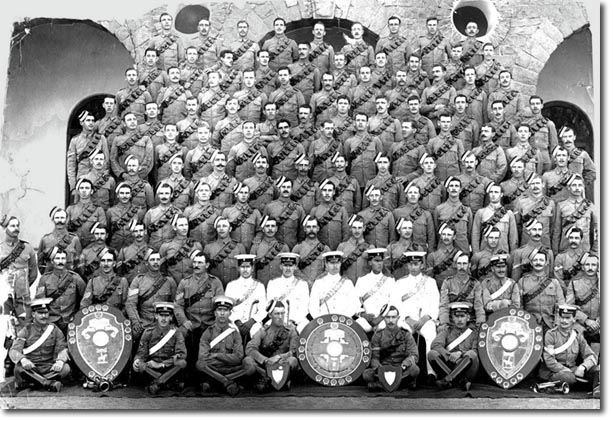|
|

 |
|
The 13th Hussars were stationed in India between 1904 and 1914. This photo of the 116 men of C Squadron, in Trimulgherry, shows some interesting orders of dress. They are wearing khaki coloured service dress in a light material for hot climates. The buttons are brass and there are no collar badges. The head gear worn by most of them is the old pill-box cap which was phased out in the cavalry from around 1902. The cap is of blue material with a white cap-band and white braiding decoration on the top. For some reason the rear five rows are not wearing any head gear. Sergeants and above wear gold lace and braid instead of white. The caps are worn at an acute angle on the right side of the head and kept on with a thin black patent leather strap.
Some men at the front are wearing the newly introduced peaked forage caps which style is still worn in today's army, over a hundred years later. These caps have a dark blue cap band and white top. The badge is the same design as the Puggaree Badge but different from the officer's badge. The men wearing these caps are trumpeters, and are also distinguished by their white pouch belts worn on the left shoulder. These were worn by all the men prior to 1900 but after that date the full dress uniform was worn by Other Ranks without the pouchbelt. The brown leather ammunition pouches worn in place of the white pouchbelt can be seen here worn by all the men except for officers and trumpeters. There are two types, the old type worn by most of the sergeants in the second row, and the 1903 type worn by the rest of the men. The officers in their white uniforms can be seen more clearly in Officers c1907 and two of the trumpeters can be seen in Trumpet-Major and Trumpeter c1907 |
13th Hussars: Uniforms | Regimental details
Armed Forces | Art and Culture | Articles | Biographies | Colonies | Discussion | Glossary | Home | Library | Links | Map Room | Sources and Media | Science and Technology | Search | Student Zone | Timelines | TV & Film | Wargames